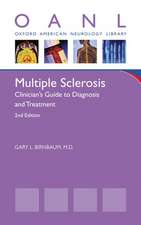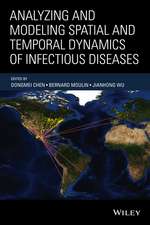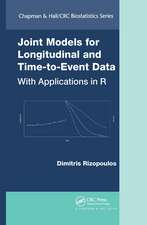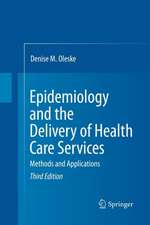Mathematical and Statistical Approaches to AIDS Epidemiology: Lecture Notes in Biomathematics, cartea 83
Editat de Carlos Castillo-Chavezen Limba Engleză Paperback – 20 dec 1989
Din seria Lecture Notes in Biomathematics
-
 Preț: 378.54 lei
Preț: 378.54 lei -
 Preț: 380.45 lei
Preț: 380.45 lei -
 Preț: 413.37 lei
Preț: 413.37 lei -
 Preț: 390.63 lei
Preț: 390.63 lei -
 Preț: 396.24 lei
Preț: 396.24 lei -
 Preț: 387.38 lei
Preț: 387.38 lei -
 Preț: 385.08 lei
Preț: 385.08 lei - 5%
 Preț: 366.56 lei
Preț: 366.56 lei -
 Preț: 384.70 lei
Preț: 384.70 lei -
 Preț: 388.13 lei
Preț: 388.13 lei -
 Preț: 394.29 lei
Preț: 394.29 lei - 5%
 Preț: 389.93 lei
Preț: 389.93 lei - 5%
 Preț: 370.74 lei
Preț: 370.74 lei -
 Preț: 384.86 lei
Preț: 384.86 lei -
 Preț: 387.96 lei
Preț: 387.96 lei -
 Preț: 404.29 lei
Preț: 404.29 lei -
 Preț: 391.61 lei
Preț: 391.61 lei -
 Preț: 384.48 lei
Preț: 384.48 lei -
 Preț: 384.48 lei
Preț: 384.48 lei -
 Preț: 383.71 lei
Preț: 383.71 lei -
 Preț: 379.68 lei
Preț: 379.68 lei -
 Preț: 384.09 lei
Preț: 384.09 lei -
 Preț: 405.66 lei
Preț: 405.66 lei -
 Preț: 379.48 lei
Preț: 379.48 lei -
 Preț: 400.65 lei
Preț: 400.65 lei -
 Preț: 385.25 lei
Preț: 385.25 lei -
 Preț: 390.25 lei
Preț: 390.25 lei -
 Preț: 395.47 lei
Preț: 395.47 lei -
 Preț: 378.71 lei
Preț: 378.71 lei -
 Preț: 382.95 lei
Preț: 382.95 lei - 15%
 Preț: 578.01 lei
Preț: 578.01 lei -
 Preț: 380.84 lei
Preț: 380.84 lei -
 Preț: 405.66 lei
Preț: 405.66 lei -
 Preț: 399.12 lei
Preț: 399.12 lei -
 Preț: 410.66 lei
Preț: 410.66 lei -
 Preț: 385.62 lei
Preț: 385.62 lei - 5%
 Preț: 371.10 lei
Preț: 371.10 lei -
 Preț: 378.71 lei
Preț: 378.71 lei -
 Preț: 386.99 lei
Preț: 386.99 lei -
 Preț: 401.61 lei
Preț: 401.61 lei -
 Preț: 350.30 lei
Preț: 350.30 lei -
 Preț: 383.33 lei
Preț: 383.33 lei -
 Preț: 408.54 lei
Preț: 408.54 lei -
 Preț: 398.53 lei
Preț: 398.53 lei -
 Preț: 399.67 lei
Preț: 399.67 lei -
 Preț: 391.79 lei
Preț: 391.79 lei -
 Preț: 384.86 lei
Preț: 384.86 lei -
 Preț: 401.61 lei
Preț: 401.61 lei -
 Preț: 392.60 lei
Preț: 392.60 lei -
 Preț: 406.05 lei
Preț: 406.05 lei
Preț: 378.97 lei
Preț vechi: 398.92 lei
-5% Nou
Puncte Express: 568
Preț estimativ în valută:
72.54€ • 78.82$ • 60.97£
72.54€ • 78.82$ • 60.97£
Carte tipărită la comandă
Livrare economică 21 aprilie-05 mai
Preluare comenzi: 021 569.72.76
Specificații
ISBN-13: 9783540521747
ISBN-10: 3540521747
Pagini: 424
Ilustrații: IX, 405 p. 20 illus.
Dimensiuni: 170 x 242 x 22 mm
Greutate: 0.67 kg
Ediția:Softcover reprint of the original 1st ed. 1989
Editura: Springer Berlin, Heidelberg
Colecția Springer
Seria Lecture Notes in Biomathematics
Locul publicării:Berlin, Heidelberg, Germany
ISBN-10: 3540521747
Pagini: 424
Ilustrații: IX, 405 p. 20 illus.
Dimensiuni: 170 x 242 x 22 mm
Greutate: 0.67 kg
Ediția:Softcover reprint of the original 1st ed. 1989
Editura: Springer Berlin, Heidelberg
Colecția Springer
Seria Lecture Notes in Biomathematics
Locul publicării:Berlin, Heidelberg, Germany
Public țintă
ResearchCuprins
Statistical and Mathematical Approaches in HIV/AIDS Modeling: A Review.- I. Statistical Methodology and Forecasting.- Epidemic Models, Empirical Studies, and Uncertainty.- Predicting AIDS Incidence by Extrapolating from Recent Trends.- II. Infectivity and the Human Immunodeficiency Virus (HIV).- Measuring HIV Infectivity.- The Stages of HIV Infection: Waiting Times and Infection Transmission Probabilities.- Modeling Heterogeneity in Susceptibility and Infectivity for HIV Infection.- On the Role of Variable Infectivity in the Dynamics of the Human Immunodeficiency Virus Epidemic.- III. Heterogeneity and HIV Transmission Dynamics.- Assessment of the Risk of HIV Spread Via Non-steady Heterosexual Partners in the U. S. Population.- On the Role of Long Incubation Periods in the Dynamics of Acquired Immunodeficiency Syndrome (AIDS). Part 2: Multiple Group Models.- Nonrandom Mixing Models of HIV Transmission.- IV. Social Dynamics and AIDS.- The Structure and Context of Social Interactions and the Spread of HIV.- Pair Formation in Sexually-Transmitted Diseases.- Mixing Framework for Social/Sexual Behavior.- Interaction, Pair Formation and Force of Infection Terms in Sexually Transmitted Diseases.- Structured Mixing: Heterogeneous Mixing by the Definition of Activity Groups.- Selective Contact within Structured Mixing with an Application to HIV Transmission Risk from Oral and Anal Sex.- V. The Immune System and the HIV.- Modeling the Interaction of the Immune System with HIV.- Modeling the Interaction of HIV with Cells of the Immune System.- When HIV meets the Immune System: Network Theory, Alloimmunity, Autoimmunity, and AIDS.












